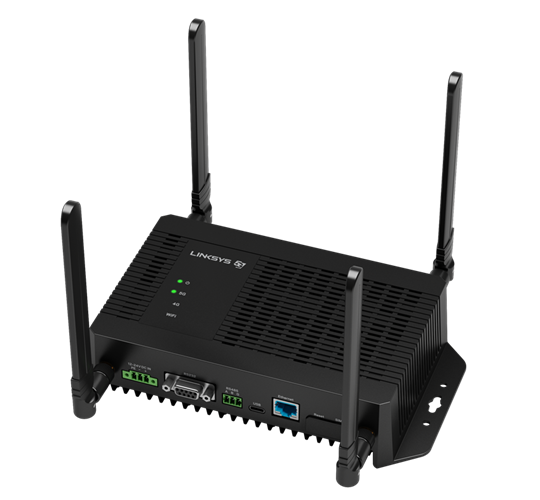
HARDWARE INFORMATION
The parts of the Linksys FGMM1000 are the following:
- Power button (three-pin connector)
- One RS232 serial port
- One RS485 serial port
- One USB-C port for debugging
- One 2.5 Gigabit ethernet port
- Reset button/pinhole (remove cover to see the button)
- NANO USIM slot (remove the cover to see the slot)
- Indicator lights – Learn more about the Linksys FGMM1000 light behavior.
Below are the major product features of the Linksys FGMM1000:
- 5G Wi-Fi® 6 Industrial router
- 5G Sub-6 GHz and mmWave
- Network deployment:
- Option 3x/3a for Non-Standalone Architecture (NSA
- Option 2 for Standalone Architecture (SA)
- 802.11ax simultaneous dual-band AX1800
- IP30 rating
- Port Forwarding
- Port Filtering
- 2x2 Spatial streams
- Supports Nano SIM card
- Dimensions: 224.5 mm x 123.1 mm x 49 mm (L x W x H)
- Weight: 850 g
No. The USB port is non-functional and is used for debugging purposes only.
SETUP AND INSTALLATION
Get started with the Linksys FGMM1000 setup.
The Linksys FGMM1000 has the following default settings:
- The IP address is 192.168.100.1.
- The default WiFi name and password are located on the product label.
- The default login username and password are
user. - The default administrator login username and password are
administrator. - The default SSID is
Linksysxxxxx(the last five characters are the last five digits of the serial number).
FEATURES AND FUNCTIONS
View steps to access the Linksys FGMM1000 web interface.
The Linksys FGMM1000 supports the following WiFi security types:
- WPA™ Personal
- WPA2™ Personal
- WPA3™ Personal
- WPA/WPA2-Personal Mixed Mode
- WPA2/WPA3-Personal Mixed Mode
The Linksys FGMM1000 can connect up to 32 clients.
TROUBLESHOOTING
If you have forgotten the login password, you may reset your device.
If you are experiencing 5G or 4G connectivity issues, make sure the SIM card is inserted properly. If you are still having other connectivity issues, contact the administrator who configured the Linksys FGMM1000.
To resolve this, connect a computer to the router via an ethernet cable. Then, log in and go to the Network page. Under WiFi settings, make sure the WiFi feature is enabled.




